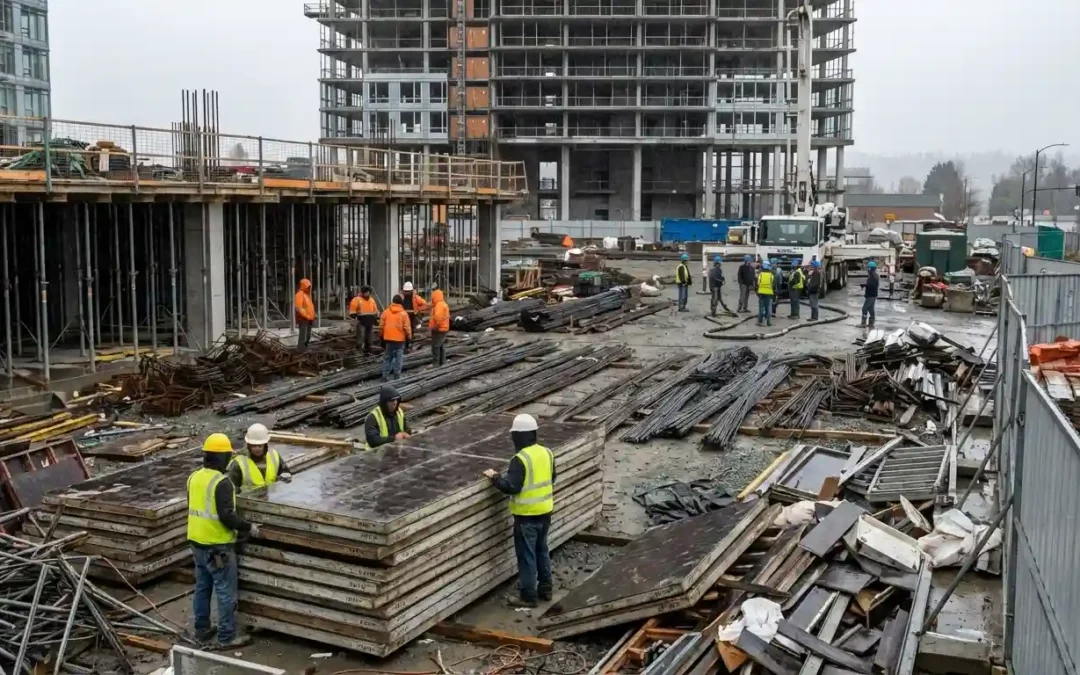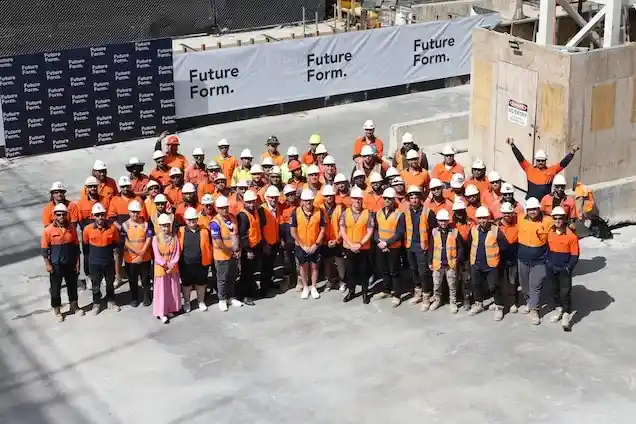
Why the Right Framework Matters
In the fast-paced world of construction, every decision—no matter how foundational—can make or break timelines, budgets, and long-term performance. One of the most fundamental yet often misunderstood choices developers and builders face is between traditional formwork systems and comprehensive FRP services—Formwork, Reo, and Pour. These two approaches are often used interchangeably in conversation, but their scope, function, and impact are vastly different.
At Future Form, we know how critical it is to choose the right method to match the needs and vision of your build. Whether you’re working on a high-rise, industrial warehouse, or residential development, understanding this distinction can help you save on costs, reduce risk, and stay on the front foot with innovation.
What is Formwork?
Formwork refers to the temporary or permanent moulds into which concrete is poured to create structural elements—walls, slabs, columns, and beams. Think of it as the skeleton that shapes your concrete before it hardens.
In many countries, traditional formwork has long been the backbone of vertical construction. Common types include:
- Conventional timber formwork – easy to source and flexible on site, but labour-intensive.
- Engineered formwork systems – such as modular steel or aluminium frames, offering faster setup and reuse.
- Jumpform and slipform systems – used for high-rise cores and continuous pours.
While modern systems have evolved significantly, formwork on its own is just one part of the bigger picture. That’s where FRP comes in.
What is FRP (Formwork, Reo, Pour)?
In the construction world, FRP doesn’t just stand for Fibre Reinforced Polymer. When we talk about FRP services, we’re referring to the combined process of:
- Formwork – as above.
- Reinforcement (Reo) – the placement of steel bars or mesh to strengthen the concrete.
- Pour – the actual concreting stage.
Together, this trio forms the entire structural package for concrete work. FRP is not a material; it’s a methodology, an integrated service model that takes your build from prepped site to solid, reinforced concrete.
Think of it as a full-circle offering that removes the coordination burden from your team, reduces scope gaps, and often improves build quality through accountability and consistency.
Formwork vs FRP: Key Differences
| Feature | Formwork Only | FRP |
| Scope | Provides moulds for concrete pours | Includes formwork, reinforcement and pour |
| Responsibility | Usually one subcontractor | Single entity managing all three components |
| Coordination | Requires site team to manage trades | Seamless integration between tasks |
| Risk | HIgher: misalignment or delays common | Lower: better scheduling and handover |
| Efficiency | Variable depending on trade interaction | High: Fewer Stoppages, streamlined workflow |
| Cost Predictability | Subject to variation due to trade issues | Often more predictable and transparent |
This table lays out the real-world differences that can influence your project outcomes. While traditional formwork offers flexibility and may suit certain project models, it leaves a significant portion of coordination, risk management, and quality control in the hands of the site team. In contrast, FRP services take a holistic, integrated approach—covering all three critical stages in one streamlined package. For developers and construction professionals looking to reduce delays, increase certainty, and minimise management stress, FRP isn’t just a structural solution—it’s a strategic one.
When Might Standalone Formwork Be More Suitable?
That said, traditional formwork-only contracts aren’t obsolete. You might still choose to use standalone formwork if:
- Your team has in-house steel fixers and concrete crews.
- You prefer tighter control over every trade.
- The job is small-scale and doesn’t justify an FRP package.
- Procurement is structured for separate tendering.
However, these are becoming rarer in today’s fast-paced builds.
The Benefits of Choosing FRP Over Standalone Formwork
Streamlined Scheduling
With one team handling formwork, reo, and pour, your Gantt chart becomes cleaner—and your days more predictable. No more waiting for one trade to finish so the next can start.
Accountability at Every Stage
When one provider owns the entire package, there’s no room for finger-pointing. We take responsibility for alignment, safety, quality control, and timelines.
Time and Cost Savings
Although FRP packages may appear more expensive up front, they typically lead to fewer variations, less rework, and reduced site management costs in the long run. According to a 2023 report by the Australian Constructors Association, integrated construction services improve efficiency by up to 12% on average (Australian Constructors Association, 2023).
Improved Safety
Fewer trades on site, tighter sequencing, and consistent safety protocols across all three stages reduce risks—a priority for any developer or builder.
Build Quality and Compliance
At Future Form, our end-to-end teams follow strict Australian Standards for concrete construction (AS 3600), steel reinforcement (AS/NZS 4671), and formwork systems. This ensures structural integrity and long-term durability.
FRP Services: Future Form’s Integrated Approach
Choosing the right delivery model for your structural works isn’t just about scope—it’s about synergy. When formwork, reinforcement, and concrete pours are managed separately, projects can face gaps in timing, communication, and responsibility. That’s why more builders are turning to integrated service models that deliver cohesion as well as concrete.
At Future Form, our team specialise in delivering FRP packages that align with your site timelines and structural goals. With extensive experience across commercial, industrial, and residential developments, we’re proud to be a trusted partner for:
- Full core construction (formwork, reo, pour)
- Basement and podium deck pours
- Lift shaft structures
- High-rise suspended slabs
Our integrated crews don’t just deliver; they understand the bigger picture. From the engineer’s drawings to the site’s logistics, our team brings cohesion that minimises downtime and error.
Case Study: Smith St, Parramatta
This masterpiece tower located in the heart of Parramatta continues to draw attention from construction professionals across the country. Rising 28 storeys high, the project showcases striking off-form structural elements, including curved jump-form cores that push the limits of vertical construction.
Future Form managed the entire FRP scope—Formwork, Reo, and Pour—on this iconic development, enabling precise coordination across all stages of the structure. The building’s high strutting soffits and monumental columns added a level of complexity that demanded expert planning, sequencing, and pour control.
By delivering a comprehensive FRP solution, we were able to:
- Accelerate structural delivery by 18 days, despite the complexity of the curved elements.
- Avoid over $100,000 in coordination variations, thanks to integrated scheduling and a single point of accountability.
- Achieve an exceptional finish on the exposed soffits—an architectural feature that adds to the building’s bold presence.
Developers noted that the unified FRP approach not only ensured structural excellence but also reduced site stress and simplified communication, with one team leading all concrete works from start to finish.
Final Thoughts: Think Beyond the Frame
As many countries shifts towards offsite fabrication, modular construction, and leaner site crews, bundled service models like FRP are becoming increasingly attractive. The demand for certainty and efficiency has never been higher. Formwork is foundational, but it’s no longer enough on its own. FRP packages offer a way forward that reduces fragmentation and lifts project performance from day one.
At Future Form, we see FRP not as a trend, but as the next standard. Our aim is to help visionary builders and developers create safer, faster, and better-built environments. For developers with a vision, construction professionals who value time, and suppliers who want smoother workflows, FRP might just be the missing link. And at Future Form, we’re ready to make it happen. Whether you’re in early design stages or halfway through structural planning, we’re here to help. Let’s explore how integrated FRP services can give your project the edge.
Bibliography (APA Style)
Australian Constructors Association. (2023). Integrated construction services: Efficiency insights for 2023. https://www.constructors.com.au
Standards Australia. (2021). AS 3600: Concrete structures. https://www.standards.org.au
Standards Australia. (2019). AS/NZS 4671: Steel reinforcing materials. https://www.standards.org.au
NSW Government. (2022). Construction industry performance report. https://www.nsw.gov.au





